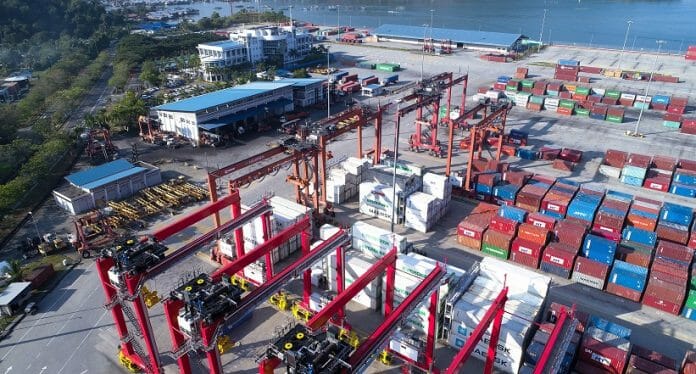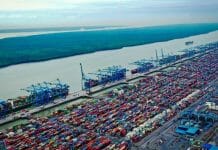In a 2 part-series, Nazery Khalid looks at efforts made by container port operators and authorities to reduce their carbon footprint. The first half of the article can be found here.
By Nazery Khalid,
Driving forces
To understand where this ‘green impetus’ at ports is coming from, it would be helpful to know the forces driving their owners, operators and even port authorities. The prime driving forces are:
- Changing philosophy towards port business. As awareness of climate change increases and the composition of shareholders in port operating companies changes, the philosophy of port authorities and port operating companies also shift in tandem. Environmentally conscious shareholders and regulatory authorities demand the ports under their management to embed health, safety and environment (HSE) philosophy and benchmark against international standards in their operations. For example, Johor Port Authority which is the authority for Port of Tanjung Pelepas and Johor Port, two internationally renowned commercial ports, has released a document called Green Port Policy which acts as a guide for the ports in making business decisions, development and operations towards attaining sustainability and enhancing the competitiveness of ports in the state of Johor Darul Takzim.
- Growing pressure from societies, coastal communities, businesses and also industries for key trade infrastructures such as ports, airports, transport terminals, industrial zones and logistics parks to operate and conduct themselves in an environmentally conscious way. Rising signs of a distressed planet such as ocean level rising, extreme and unpredictable weather patterns and melting polar have driven industry practitioners to be more mindful of the impacts of their business on the environment. This awareness has driven port operators and owners to invest in green technologies and appropriately trained human capital, rethink business strategies and offer services to their customers in a way that minimizes adverse effects to the environment.
- Changes in dynamics of shipping industry. The principle users of ports are shipowners. As such, developments in the shipping industry have a significant impact on how ports are planned, built, expanded, operated, administered, regulated and even marketed. As ships become more environment friendly – in adherence with international conventions formulated by the International Maritime Organization (IMO) on matters such as sulphur emissions, ballast water management and ship recycling – they are equipped with more eco-friendly, energy efficient features and onboard equipment. These ships require ports to match their eco-friendly features to serve them efficiently, hence making it necessary for port operators to invest in green features and technology to keep to speed with the handling demands of these important customers of theirs.
- Availability of new innovative green technologies to enable emissions from port assets and hardware to be reduced. For example, electric-powered port cranes has replaced those running on diesel which spew carbon into the environment, and LED floodlights are increasingly being used at ports around the world to reduce electricity consumption. Leading ports encourage shipowners to reduce energy consumption by offering eco-friendly facilities. Port of Oslo in Norway which has an onshore power that allows ferries and cruise ships to connect to power while berthing at the port, hence reducing their emissions and safeguarding the environment. At the Port of Oakland in the USA, 75% of all ships visiting use shore power to help reduce emissions. Southampton Port in England has installed more than 2,000 roof-mounted solar panels on its largest cruise terminal building to make it carbon-neutral.
- Increased focus on environmental safety at ports, thanks to a combination of stronger port safety regulations (at the national, regional and international levels), technological advent of safety-related assets and solutions, recruitment of well-trained security personnel, and greater vigilance and better response capability towards environmental related areas such as waste handling, oil spill clean-up and hazardous materials and dangerous goods management. The price to pay for non-compliance with environmental regulations can not only be financially severe but port operators who violate such rules stand to lose credibility as business entities and the goodwill of their users, host community, regulatory agencies and society in general. Repeat and serious offenders may even get their licenses to operate ports suspended by regulatory authorities.
- Better collection and use of environment-related data – thanks to advent in Industry 4.0 areas such as Internet of Things, Big Data Analytics and Artificial Intelligence, among others. Data collection, storage and processing technologies have allowed port operators and authorities to make more informed decisions in running their ports and planning their strategies. They have enabled data in areas such as GHG and particulates emissions levels, pollution of harbor waters, noise levels and non-eco friendly ships, among others, to be better collected, retrieved, updated, shared, analyzed and simulated. These data help port operators to install green technologies, reconfigure their ports to become cleaner and greener and plan their environment management strategies to be carbon neutral.
- The pursuit for niche branding amid intense port competitiveness landscape. With more ports beefing up their infrastructures and facilities, and improving efficiency, productivity and offering high quality services at competitive rates, their operators are hard-pressed to create differentiation for themselves to remain on the radar of shipping lines and other users. As it is almost a given that major ports have all the features mentioned, those with unique value propositions will truly stand out. One of the areas from which they can gain competitive advantage is being environmental friendly. There is growing evidence that eco-friendly ports can also be profitable ports as they brand themselves to be economically attractive to their users. Green ports with shore power facilities for example help shipping lines reduce their fuel consumption hence generate economic advantage to them. This leads to repeat business from environmentally conscious port users who will keep on coming back to the ports for the eco-friendly facilities and services they provide.
Green is in
It is encouraging to see that more and more owners and operators of commercial ports and passenger terminals are aligning their operations with an environment-centric approach to become carbon-neutral.
A combination of factors including greater awareness of environmental issues, regulatory push, social expectation, technological advent, growing investment into green technologies, changing business philosophies and competition dynamics has catalyzed them to carry out their business in a more environmentally conscious and responsible manner.
As the adverse effects of climate change continue to manifest themselves, and governments commit to reduce emissions levels, individuals, businesses and industries will be increasingly expected to play their parts in reducing carbon footprint, wastes and pollution and use resources in a more judicious fashion. Saving the planet is a collective responsibility, not a task that rests on the shoulders of one party alone.
Ports certainly are not exempted from this expectation. Being one of the most prominent and critical facilitators of global trade and a component on marine tourism, they are expected to be at the forefront in leading efforts among marine industry players to curb emissions from activities.
It is encouraging to see that more owners and operators of ports and terminals are embracing the green philosophy and embedding it into their business and strategies. This fits into their high-profile role in enabling today’s trade-oriented modern economy to function and flourish.
That said, more needs to be done to get more owners and operators of ports and terminals to operate in a carbon-neutral way. In many developing and under-developing countries, there are many small ports and private jetties which use outdated, energy inefficient equipment and do not have the infrastructures, facilities and human capital to operate in an environmentally friendly fashion.
The owners and operators of some ports lack the financial resources and technical capacity to undertake environmental management of their ports. Some countries do not have the regulatory set-up and institutional and enforcement means to introduce strong environmental rules and regulations, and there is low awareness of the need to operate infrastructures like ports in an eco-friendly manner there. These are among some of the issues that need to be addressed to help ports operating in a non-environmentally clean and safe way to raise themselves to acceptable levels.
International spotlight will continue to shine brightly on port owners and operators to play a significant role in helping the marine industry play its part to reduce emissions and reverse global warning. But this is not a battle for them to fight alone. They need the full and sustained support of governments, international maritime bodies such as IMO, port users, coastal communities, industries, businesses and the research communities, among other stakeholders of ports and the marine industry, to work in concert to help ports operate in a carbon-neutral manner for the collective benefit of all and for the sake of the environment.
Nazery Khalid is a prominent writer, commentator and international speaker of various subjects in the field of maritime. He can be contacted at [email protected]









